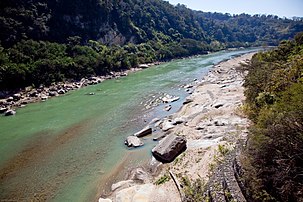regions, biodiversity
- Patagonia, a large southern plateau consisting mostly of arid, rocky steppes[104] to the east, moister cold grasslands to the south and dense subantarctic forests to the west.[117]
Biodiversity
Argentina is a megadiverse country[118] hosting one of the greatest ecosystem varieties in the world: 15 continental zones, 3 oceanic zones, and the Antarctic region are all represented in its territory.[118] This huge ecosystem variety has led to a biological diversity that is among the world's largest:[118][119]
- 9,372 cataloged vascular plant species (ranked 24th)[I]
- 1,038 cataloged bird species (ranked 14th)[J]
- 375 cataloged mammal species (ranked 12th)[K]
- 338 cataloged reptilian species (ranked 16th)
- 162 cataloged amphibian species (ranked 19th)
Climate
Although the most populated areas are generally temperate, Argentina has an exceptional climate diversity, ranging from tropical in the north[120] to subpolar in the far continental south.[121] Climate patterns roughly follow the geographic regional division:[H]
- The Northwest climate is varied, with rainfall diminishing north to south and east to west:[110] Puna, to the high Andean west, is dry and with great temperature fluctuation but cold overall, frequently falling below freezing point at night;[110] Yungas, to the east, are tropical, very hot and moist.[122]
- Mesopotamia is subtropical overall, with hot and very humid tropical climate in the north,[123] and gradually becoming temperate and semi-humid to the south.[124]
- Gran Chaco has very hot subtropical to tropical climate,[120] and humid summers with mild drier winters. With heavy seasonal rainfalls,[124] it is subject to periodic droughts.[125]
- Cuyo is generally mild, although mountainous areas have alpine climate with temperatures below freezing much of the year.[126]
- Pampas and Sierras Pampeanas are temperate, with hot, stormy summers and cool winters; moisture is higher in the east.[127]
- Patagonia is very windy, with mild summers and cold[110] to very cold winters[128] with heavy snowfall and frost,[110] especially in mountainous zones.[129] Precipitation steeply diminishes from west to east.[130]
Major wind currents include the cool Pampero Winds blowing on the flat plains of Patagonia and the Pampas; following the cold front, warm currents blow from the north in middle and late winter, creating mild conditions.[127] The Sudestada usually moderates cold temperatures but brings very heavy rains, rough seas and coastal flooding. It is most common in late autumn and winter along the central coast and in the Río de la Plata estuary.[127] The Zonda, a hot dry wind, affects Cuyo and the central Pampas. Squeezed of all moisture during the 6,000 m (19,685 ft) descent from the Andes, Zonda winds can blow for hours with gusts up to 120 km/h (75 mph), fueling wildfires and causing damage; between June and November, when the Zonda blows, snowstorms and blizzard (viento blanco) conditions usually affect higher elevations.[131]














